.
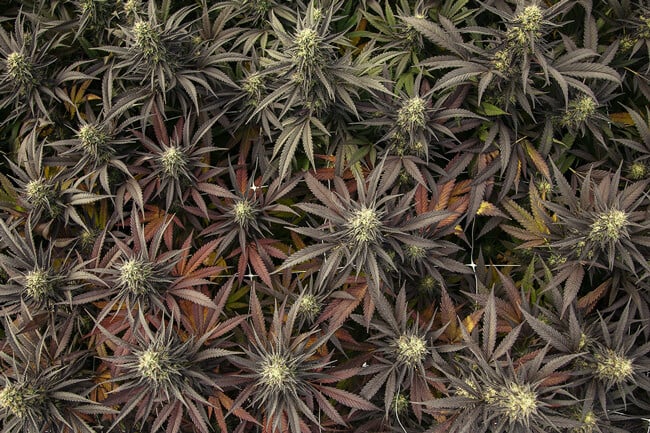
What Makes Weed Colourful?
Green. Purple. Red. Pink. Black. Cannabis can display a wide range of gorgeous colours that make it the centrepiece of any garden. But what gives it such unique hues? Several factors play a role, including pH, temperature, genetics, and an array of pigments found in the leaves and flowers. Find out about the rainbow of colours cannabis can exhibit.
Contents:
Cannabis has more nicknames than practically any other plant on Earth. Among these titles, “the green” ranks pretty high. While the majority of strains are indeed green in appearance, there are many more marijuana colours out there. Breeders have created thousands of different cultivars over the last few decades, and these efforts have given rise to substantial genetic variability. Now, growers can purchase colourful cannabis boasting hues of purple, yellow, orange, blue, red, pink, and even black.
But what underpins colourful marijuana? You’re about to find out! It boils down to genetics, environmental factors, and specialised plant-derived chemicals. Below, you’ll discover which molecules give rise to each of marijuana’s many colours, and what other roles these fascinating phytochemicals play in cannabis.
Understanding the Many Colours of Cannabis
Green fan leaves are a universal symbol of cannabis. They show up in films, merchandise, social media posts, and on album covers. While this luscious green tone does represent the colour of most strains, there’s a whole rainbow of colours out there for consumers and growers to enjoy.
But this phenomenon isn’t exclusive to cannabis. Many popular fruits and vegetables are also associated with a single colour, despite featuring significant variability. For example, when browsing through the veg section in a supermarket, you’ll come across orange carrots, green salad leaves, and red tomatoes. However, there are hundreds of heirloom varieties of each of these vegetables, and many of them are red, black, purple, and even white!
The same can be said of cannabis. While the colour of a bud doesn’t say much about how it will affect you, the ability to choose from a broad range of colours adds another element of choice and luxury to the experience. While all seedlings and young vegetative plants possess green leaves, plants usually “turn on” unique hues during the flowering stage. Here, buds, sugar leaves, and fan leaves steal the show.
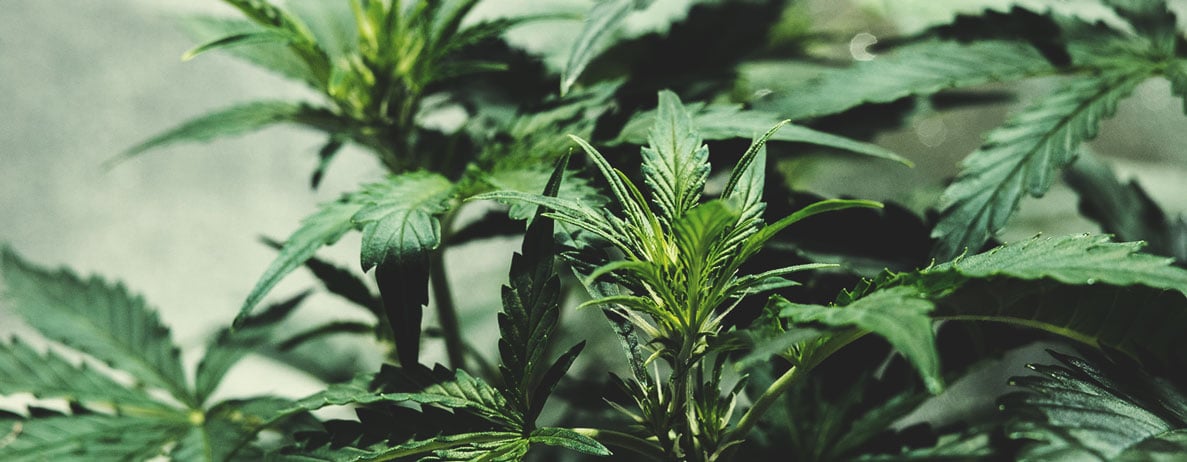
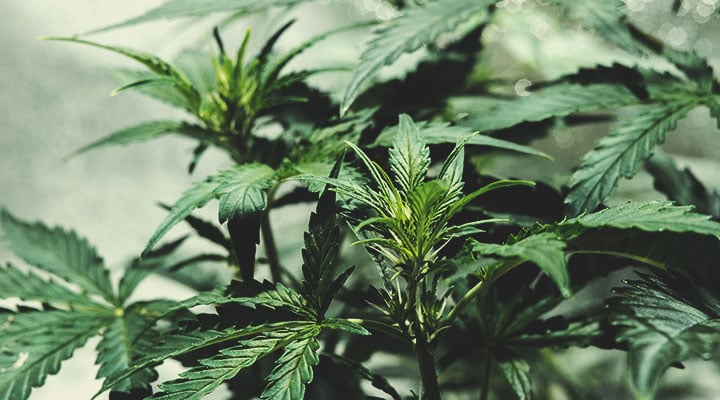
-
What Are Anthocyanins?
You’ve probably heard of anthocyanins. Classified as flavonoids, these molecules have received a lot of press in recent years due to ongoing studies probing them for potential health benefits, including antioxidant properties[1]. These colourful chemicals are responsible for tinges[3] of red, purple, and blue throughout the plant kingdom, including blueberries, red cabbage, cranberries, cherries, aubergine, and purple potatoes.
Researchers have identified over 700 anthocyanins so far. Plants create these molecules as secondary metabolites; they’re not directly involved in plant growth or development, but are instead utilised to attract beneficial insects and combat biotic (viruses, bacteria, fungi, and insects) and abiotic (UV rays and high temperatures) stressors.
These radiant phytochemicals are partly responsible for the many colours of weed, but they don’t work in isolation; pH also plays a big role[4]. Anthocyanins display reddish-purple tones at a neutral pH of 7, red-pink shades in an acidic range of 1–6, and green tones at an alkaline pH of 8–14.
What Cannabis Colours Are There?
Now, let’s take a closer look at all of the possible colours different cannabis strains can exhibit, and tap into the unique phytochemicals responsible for such gorgeous aesthetics.
-
Green (Chlorophyll)
Cannabis plants start off life as vibrant green seedlings, and the majority of them retain this colour throughout the entirety of the growing cycle. But what makes a cannabis plant green?
Chances are you remember the term “photosynthesis” from biology class. This process enables plants to convert light energy into carbohydrates that are used to support plant growth and development. At the heart of this process lies chlorophyll, a green pigment that allows plants to absorb energy from light. These molecules are housed in chloroplasts—tiny structures embedded within plant cells. These tiny organelles aren’t dissimilar to mitochondria in human cells, which help us to convert sugars and fats into energy. Ultimately, cannabis leaves appear green because the cells that make them are abundant with these minute energy factories and the green pigments that they store.


-
Yellow & Orange (Carotenoids)
If chlorophyll gives cannabis plants their green appearance, then why do some strains develop hues of orange and yellow? Good question! These striking tones are the result of another group of phytochemicals: carotenoids. Also known as tetraterpenoids, these molecules are a family of yellow, orange, and red organic pigments found in many plant species; they lend vibrant colours to carrots, papaya, squash, bell peppers, and more. Carotenoids fulfil a plethora of functions in plants[2], working as antioxidants, colour attractants, the precursors to plant hormones; they even help out when it comes to photosynthesis.
Over 750 carotenoids have been identified, and the following are known to occur in cannabis leaves:
| β-Carotene | Lutein | Violaxanthin | Neoxanthin | β-Cryptoxanthin |
| β-Carotene | Lutein | ||||||
| Violaxanthin | Neoxanthin | ||||||
| β-Cryptoxanthin | |||||||
|---|---|---|---|---|---|---|---|
Carotenoids contribute either a yellow or orange hue to cannabis leaves and flowers, depending on the concentrations present in particular cultivars. Strains best known for their orange appearance include Agent Orange and Tangerine Dream.


-
Red & Pink (Carotenoids and Anthocyanins)
Both anthocyanins and carotenoids serve up tones of red and pink. The carotenoid lutein absorbs blue light and appears orange–red at high concentrations. Anthocyanins also develop a red–pink shade when exposed to an acidic pH. Because cannabis plants thrive in a slightly acidic pH of 5.8–6.2, strains with higher quantities of these pigments are likely to develop red and pink hues in optimal conditions. Cultivars known for their red and pink colours include Black Russian, Red Poison Auto, and Panama-Sedena Red.
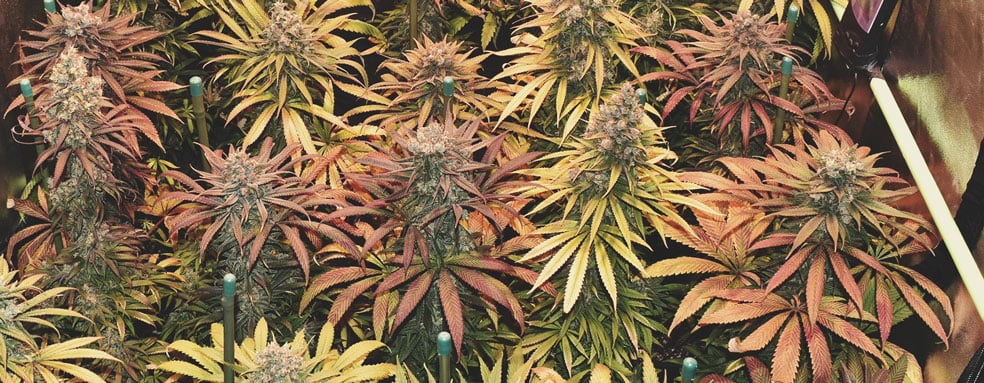

-
Purple and Blue (Anthocyanins)
Purple cannabis has become extremely popular in recent years, and many consumers and growers prefer these colourful buds to standard green options. Once again, anthocyanins underpin these brilliant shades, especially when exposed to a more neutral pH range. Purple Queen and Purple Queen Automatic stand as two of the most vibrant purple cultivars available.

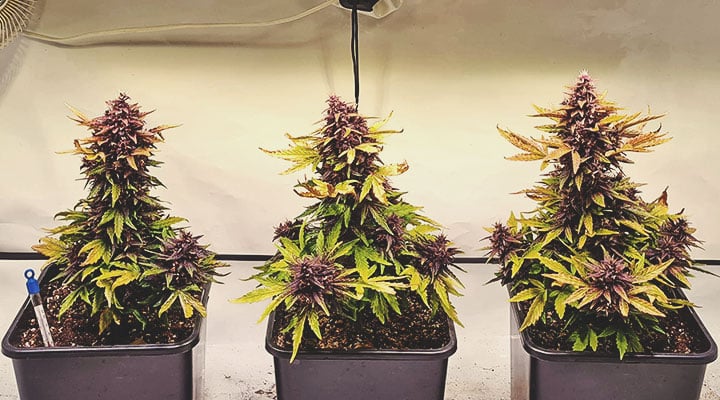
-
Black & Brown (Anthocyanins)
Cannabis plants that appear black and brown are actually displaying very deep shades of purple (similar to those seen in some types of aubergine). These strains possess high levels of anthocyanins, possibly due to a recessive gene that increases the conversion of glucose into these colourful pigments. With the right genetics, and when exposed to a more neutral pH, cannabis strains are capable of unleashing these astonishing, rich hues.

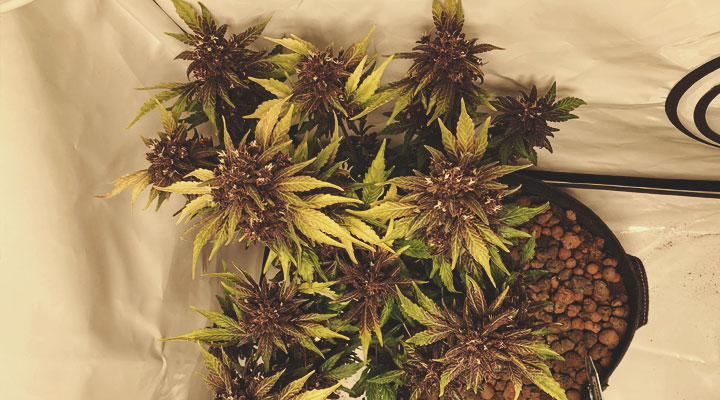
What Causes Cannabis to Change Colour?
You already know some of the main reasons why cannabis flips colours, but let's recap:
- Genetics: Some plants are hard-wired to pump out higher levels of colourful pigments. This is largely the result of extensive selective breeding.
- Specific phytochemicals: As detailed above, specific phytochemicals are responsible for certain cannabis colours. In other words, you can't expect to grow purple plants if your strain doesn't exhibit naturally high anthocyanin levels.
- pH: Different pH ranges can cause anthocyanins to express different hues.
- Stress: Certain stressors, including UV radiation, drive anthocyanin production[5].
- Temperature: The cooler nighttime temperatures at the end of a growing season (or simulated indoors) force plants to focus less on chlorophyll production as they mature, triggering a rise in anthocyanin output.
Is Bud Colour an Indication of Potency?
Colourful buds certainly look pretty—and many cannabis users prefer them—but they don’t indicate the potency or effects of specific cultivars. Strains that produce low levels of THC can produce high levels of purple pigments, and those loaded with the psychoactive cannabinoid may appear purely green. While there’s nothing wrong with considering the colour of a variety when shopping around, don’t rely on aesthetics as a measure for effects and potency.
How to Change the Colour of Cannabis
Congratulations, you’ve just stepped up your cultivation knowledge—you’re now aware of why some cannabis strains exhibit different colours. You know that anthocyanins are vibrant pigments that change colour under different pH conditions, and that some cultivars pack carotenoids responsible for expressing hues of orange and yellow. Most importantly, through picking the right genetics and controlling pH and temperature, you’re ready to start decorating your grow tent and garden with striking shades of purple, red, pink, orange, yellow, and black!
- Anthocyanidins and anthocyanins: colored pigments as food, pharmaceutical ingredients, and the potential health benefits https://www.ncbi.nlm.nih.gov
- Carotenoids as natural functional pigments https://www.ncbi.nlm.nih.gov
- Anthocyanins. Plant pigments and beyond https://pubmed.ncbi.nlm.nih.gov
- Antioxidant Properties and Stability to Heat and pH https://www.researchgate.net
- Plant stress response and adaptation via anthocyanins https://www.sciencedirect.com

































